Art & Exhibitions
‘Ceramics Are as Contemporary as a Smartphone:’ Chiara Camoni on Her Tactile Sculptures
Her new exhibition at Pirelli HangarBicocca in Milan features the largest body of work ever shown by the artist.
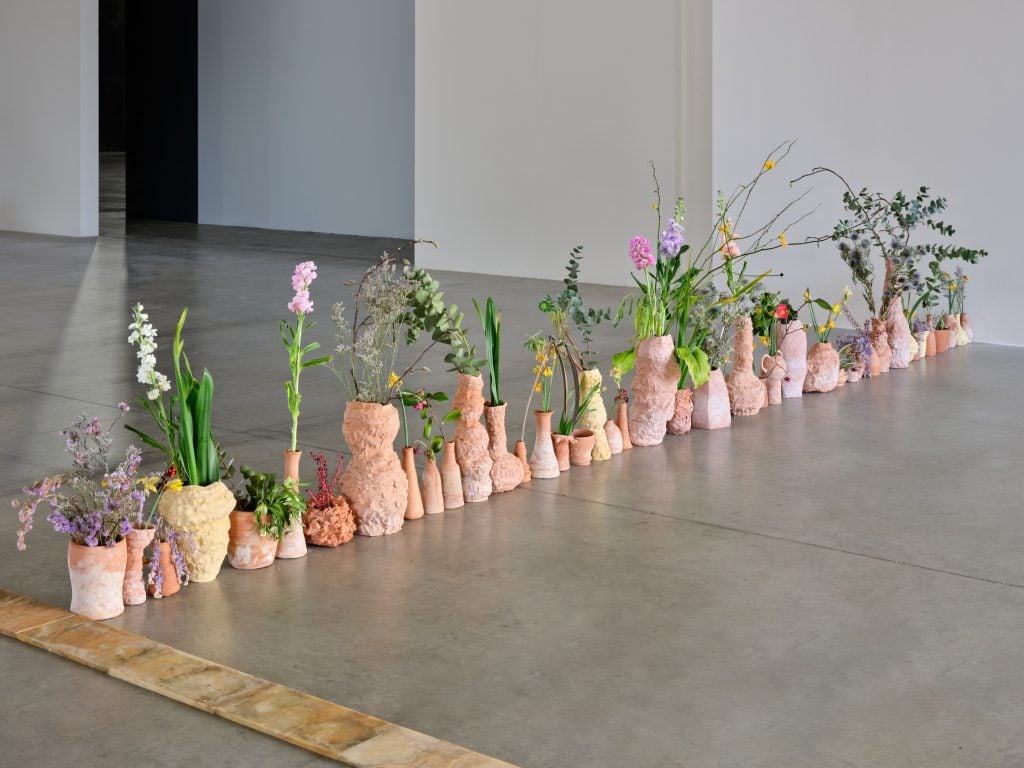
Her new exhibition at Pirelli HangarBicocca in Milan features the largest body of work ever shown by the artist.

Emily Steer

Chiara Camoni believes that there are two kinds of artists. There are “those who do not touch matter,” she says, “and those who cannot do without it.”
“I belong to this second group,” Camoni adds. That feels apparent when looking at her highly sensual works, rich organic matter mixes with tactile ceramics. Her carefully conceived sculptures explore the meeting point between domestic design and the natural world: vibrant flowers, colorful vegetation, and anthromorphized forms meet in energetic installations, which are created via her instinctive gestures.
The Italian artist also draws and makes vegetable prints; she has previously worked on expansive films. Much of this range is on view in “Call and gather. Sisters. Moths and flame twisters. Lioness bones, snakes and stones,” her new exhibition at Pirelli HangarBicocca in Milan, the largest body of work ever shown by the artist.
The exhibition’s radial floor design is inspired by Italy’s late Renaissance gardens and ancient amphitheaters, inviting viewers to wander through its various pathways or linger for a moment among individual works.
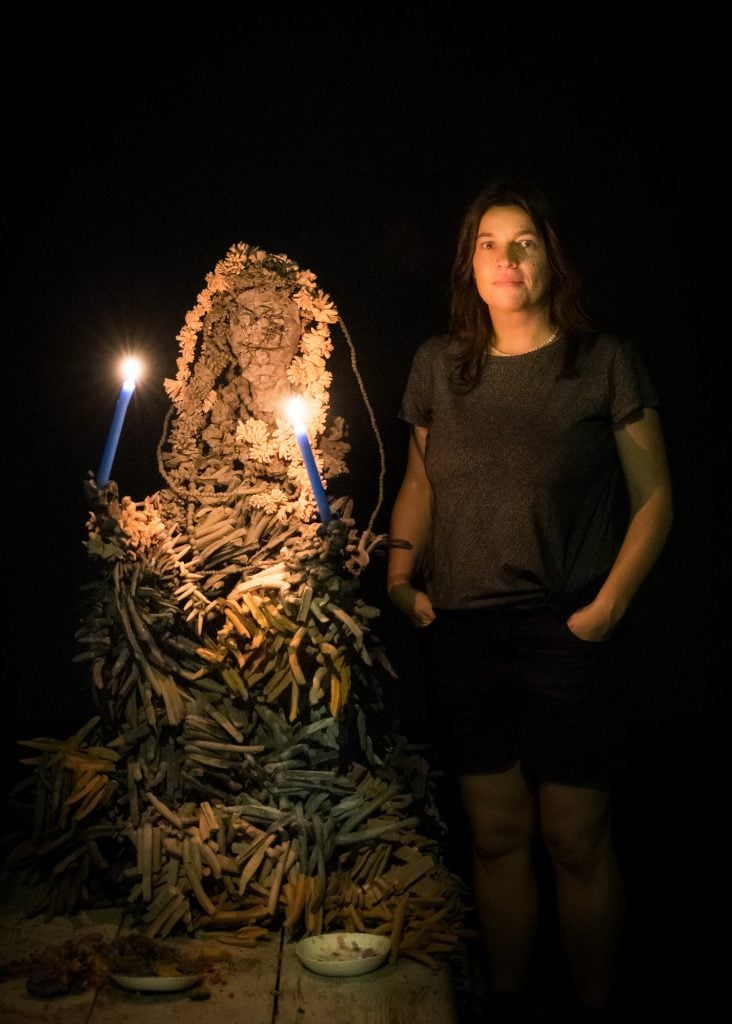
Photo: Arthur Pequin
“When I entered the Shed space at Pirelli HangarBicocca, I immediately felt the need to seek its center, then to open the doors to let the light in,” Camoni tells me in an interview. “At that point, I began to relate to the space in its entirety. Without raising walls, I drew corridors, rooms, environments. Images of archaeological sites and gardens came in, and we know that weeds, shrubs, and wild vegetation happily grow where there are ruins.”
Her Butterfly Vases (2020–22) challenge the imagined line between art and craft and are made using foraged plants. They are glazed with sand collected from local rivers and the iridescent ashes of flowers, reimagining Egyptian canopic jars, ancient food storage earthenware, and antique decorative vases.
The show also features the artist’s human-sized Sisters (2017–23), which change form through the duration of an exhibition. Some, for example, are made of wax which gradually melts, creating a constantly evolving form.
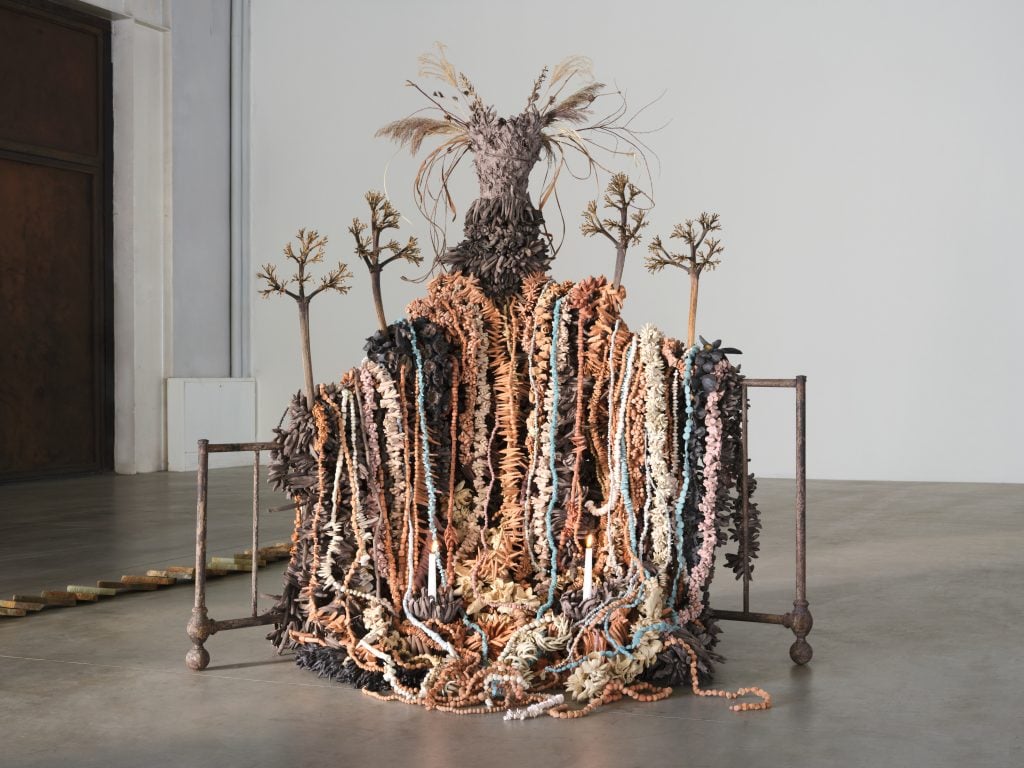
Chiara Camoni’s Sister, (2022). Installation view at Pirelli HangarBicocca, Milan, 2024. Produced by Biennale Gherdëina. Courtesy the artist; SpazioA, Pistoia, and Pirelli HangarBicocca, Milan. Photo: Agostino Osio
“I work by addressing monumentality not in terms of size, but rather in poignancy, density, reiteration of gestures, temporal duration,” Camoni says. “The Sisters are monumental figures, although they are on a human scale. They are sculptures that live in change, filled with themselves, composed of thousands of small pieces of hand-molded terracotta. They configure themselves differently each time: they come, they show off, and then they are ready to disappear again!”
Camoni’s ceramics mirror the inherently individual nature of her organic matter. They are rustic, asymmetrical, and carry the various marks and scars left by the artist’s hand. “I believe they come from an unconscious, emotional zone and do not follow the linear progression of rational thought,” she adds.
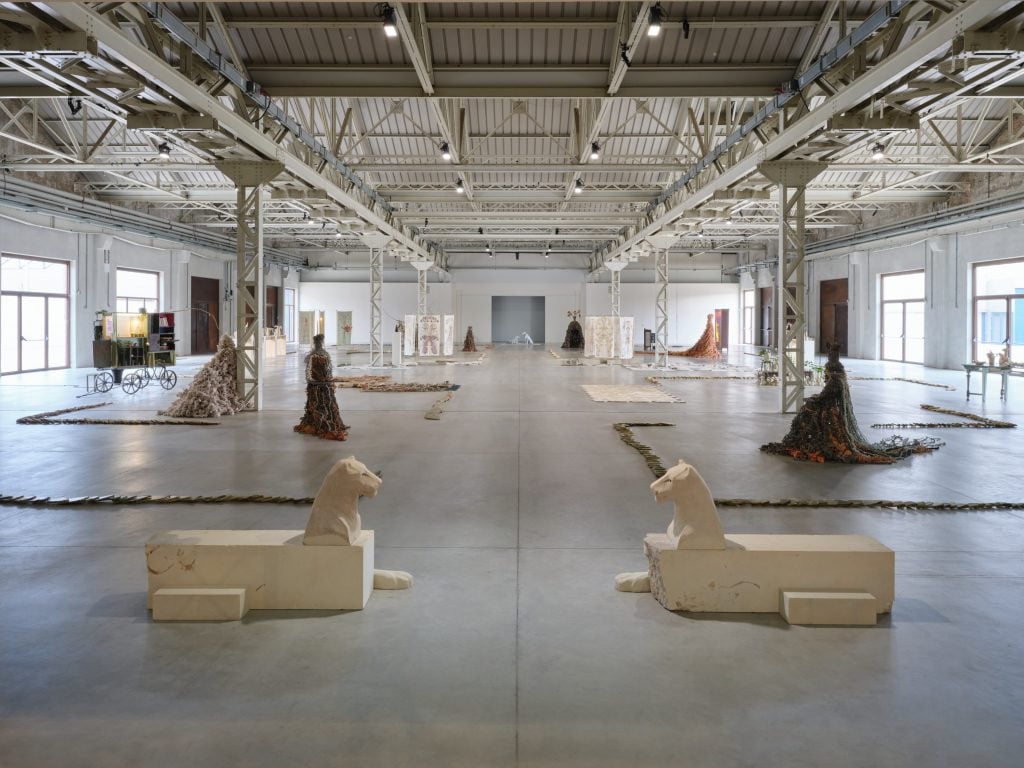
Chiara Camoni’s “Call and gather. Sisters. Moths and flame twisters. Lioness bones, snakes and stones.” Exhibition view at Pirelli HangarBicocca, Milan, (2024). Courtesy the artist and Pirelli HangarBicocca, Milan. Photo: Agostino Osio
Camoni has a highly collaborative process with nature, but also with friends and family who take part in creative workshops. “Much of my work originates at home or in the garden, conditioned by the weather and climate, as well as the surrounding sounds and voices,” she says. “I experience the wonder, the encounter with the artwork, which I consider a subject in its own right, that demands an active relationship.”
She began working together with her grandmother, Ines Bassanetti, early in her artistic practice in 2002. Bassanetti went on to become her assistant, leading to an unusually close familial artistic bond. Her grandmother created a body of plant and animal drawings with Camoni, part of La Grande Madre series. More recently, the artist invited friends and collaborators to choose books and memorabilia for Carrozzone (2021), an installation taking the form of a traditional wagon.
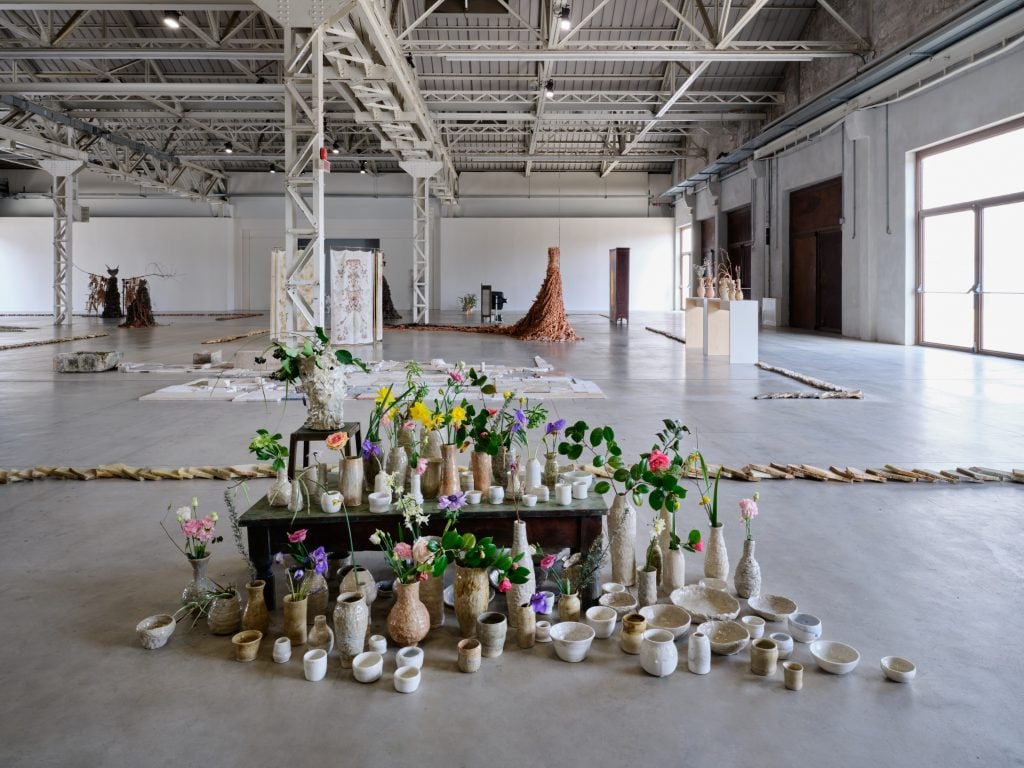
Chiara Camoni’s “Call and gather. Sisters. Moths and flame twisters. Lioness bones, snakes and stones.” Exhibition view at Pirelli HangarBicocca, Milan, (2024). Courtesy the artist and Pirelli HangarBicocca, Milan
Photo Agostino Osio
“I believe that authorship can be opened to other people,” she notes. “I like to bypass a certain technical competence, to welcome unexpected deviations. I also feel that around the artworks in the before and after—in the creative moment that precedes them and in the fruition and activation that follows—moments of intensity, little epiphanies coagulate. If I am not alone, if there is someone with me who sees and feels all this, then they really exist.”
Many of the items used in the artist’s work—from plants to ashes, sand, and soil—are collected from her surroundings. It is important to her that they come from her everyday experience, and she often transforms original materials in radical ways, sometimes burning or combining, modeling or sorting them. While she roots her practice within ancestral and archaic traditions, she also references a sense of collapsing time with her materials.
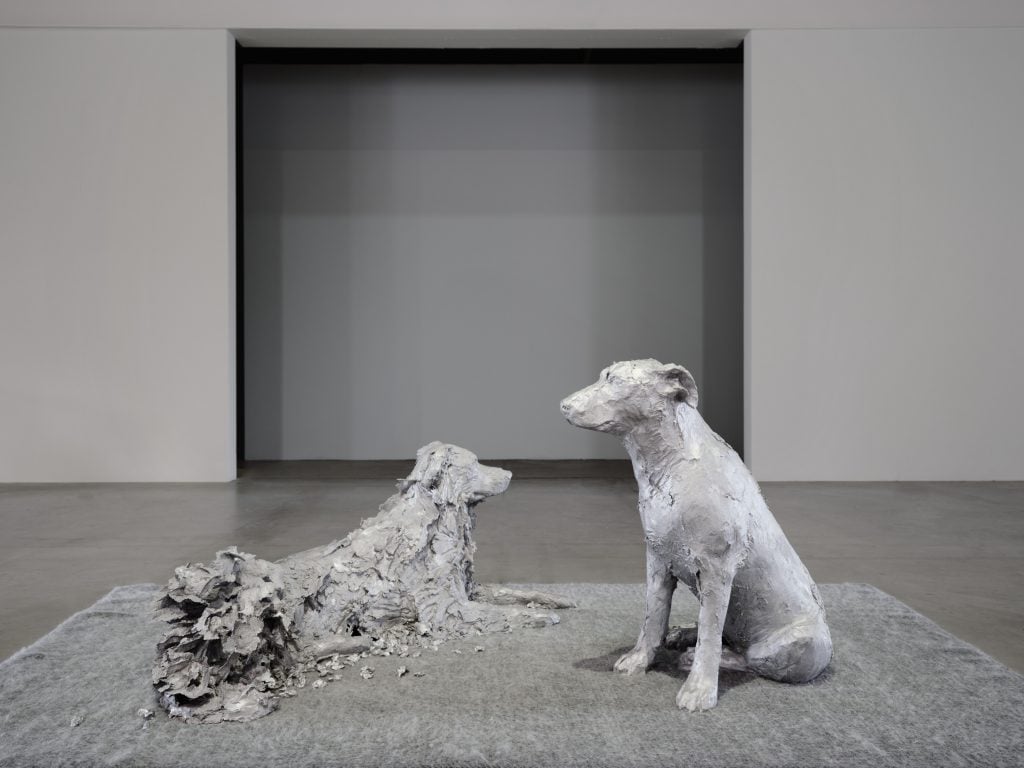
Chiara Camoni’s Dogs (Bruno and Tre), (2024). Installation view at Pirelli HangarBicocca, Milan, 2024. Produced by Pirelli HangarBicocca. Courtesy the artist; SpazioA, Pistoia, and Pirelli HangarBicocca, Milan. Photo: Agostino Osio
“Ceramics, stone, or wood are as contemporary to us as a smartphone,” she says. “It all starts with a walk, which can also take place in a city; I collect flowers, leaves, wild herbs and, thanks to the juices they release on the fabric, these figures ‘arrive.’ I consider them to be spirits hidden behind the first level of reality, as we see it.”
Camoni hopes her works create an embodied experience for the viewer, which goes beyond the visual. “This exhibition is informed with energy, which I hope will be felt,” she notes. “There is a vibration running through it all, moving in the snakes slithering low to the ground, rising in the more vertical figures, winding up and down. There are so many eyes, looking everywhere, crossing the audience’s gazes but also looking at each other…”
“Call and gather. Sisters. Moths and flame twisters. Lioness bones, snakes and stones” is on view at Pirelli HangarBicocca in Milan, through July 21, 2024.